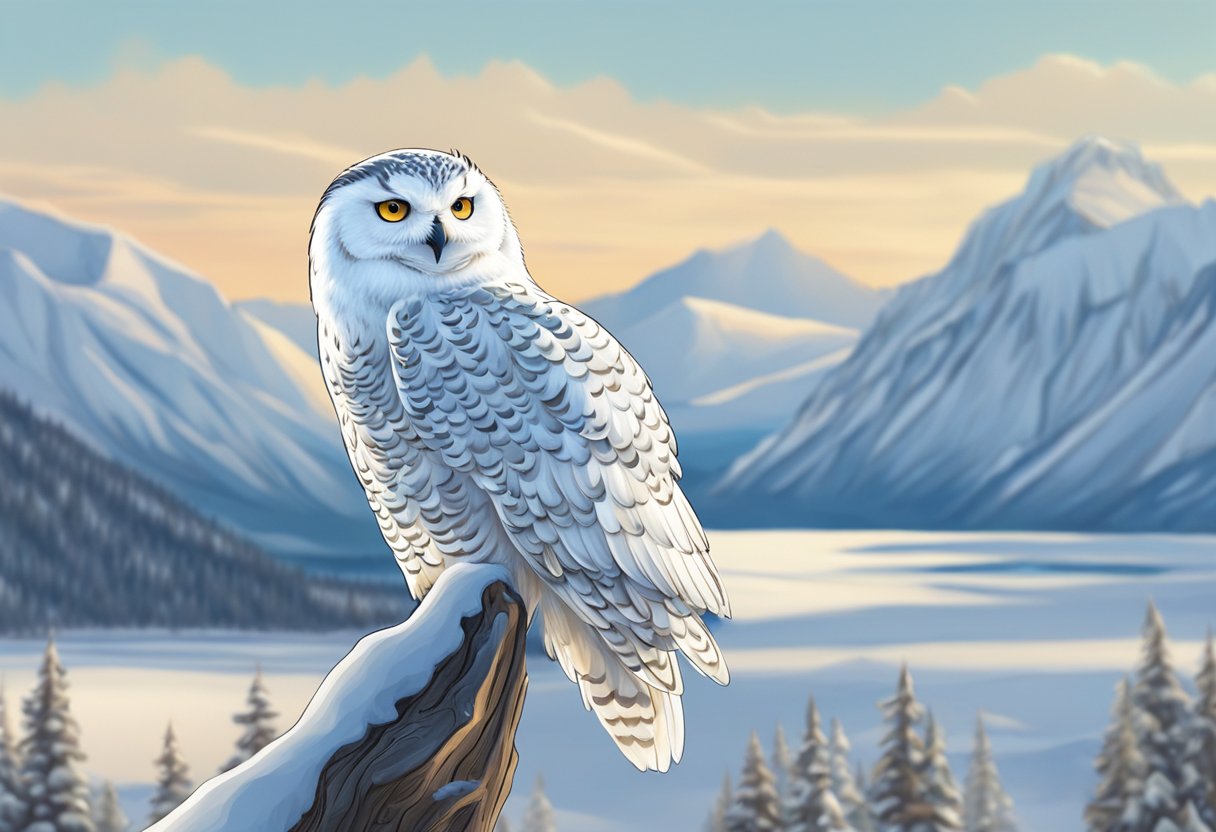Species Overview and Habitat
The snowy owl, scientifically known as Bubo scandiacus, is a striking bird known for its distinctive appearance and adaptation to Arctic environments. Its habitat primarily includes the Canadian tundra, where it thrives under specific climatic conditions.
Defining Characteristics of the Snowy Owl
The snowy owl is notable for its striking white plumage, which provides excellent camouflage against the snowy landscapes of its habitat. Adult males are predominantly white, while females exhibit a more mottled plumage with darker spots, aiding in their disguise.
They possess large, rounded heads and bright yellow eyes, which enhance their vision in low light conditions. Their keen eyesight enables them to spot prey from a distance. Snowy owls also have strong talons and wings, allowing them to capture birds and small mammals effectively.
The Snowy Owl’s North American Range
In North America, the snowy owl primarily inhabits the northern regions, particularly within Canada. They are often spotted in the Canadian Arctic and parts of the High Arctic.
During the breeding season, snowy owls may migrate southward into the northern United States, especially during irruption years, when food becomes scarce. Their movements can be influenced by winter food supply, prompting these majestic birds to travel further in search of suitable habitats.
Habitat Preferences in the Canadian Tundra
The snowy owl prefers vast, open spaces typical of the Arctic tundra. It favors locations with low vegetation, allowing for unobstructed views of its surroundings. These areas are essential for hunting, as the snowy owl relies on spotting prey from a perch.
Common perching sites include fence posts, hills, and elevated ground, which provide a vantage point for hunting. The availability of small mammals like lemmings is crucial, as they constitute a significant portion of their diet. Snowy owls also thrive in expansive landscapes, where they can effectively navigate and hunt in their frozen environment.
Breeding and Reproduction
Snowy owls exhibit distinct behaviors and strategies throughout their breeding season. These approaches ensure the successful raising of their young in the harsh conditions of the Canadian tundra.
Mating Behaviors and Courtship
During the breeding season, male snowy owls engage in elaborate courtship displays to attract a female. They perform aerial displays, showcasing their agility and strength. A male may also deliver small prey to the female as part of his courtship ritual.
Once a male successfully attracts a female, they bond through synchronized flights and vocalizations. Their choice of mate influences nesting and reproductive success. Successful courtship leads to territorial establishment, as they choose breeding grounds that provide ample food and safety for their future chicks.
Nest Building and Clutch Size
Snowy owls do not construct traditional nests. Instead, they create a simple scrape, a shallow depression in the ground, often situated near a mound or ridge. This nest site offers some protection against harsh weather conditions and predators.
The female snowy owl typically lays a clutch of 3 to 11 eggs, with an average of 5 to 7. This variation in clutch size often correlates with food availability. The eggs are usually laid over several days, ensuring the young have a staggered hatching schedule, which can enhance survival rates.
Parental Roles and Chick Development
Both parents play crucial roles in raising their chicks. The female is primarily responsible for incubating the eggs, while the male provides the majority of food. He hunts and brings prey to the nest, ensuring the female and young have sufficient nourishment.
Once hatched, the chicks are altricial, meaning they are dependent on their parents for warmth and food. They rely on the adults for sustenance, typically consuming small mammals. As they grow, the chicks begin to explore their surroundings and develop hunting skills. Within about 10 weeks, the young owls are ready to fledge and start their journey towards independence.
Diet and Hunting
The snowy owl has a specialized diet and distinct hunting behaviors that adapt with the changing seasons. Understanding these aspects is crucial to appreciating their role as predators in the Canadian ecosystem.
Prey Selection Across Seasons
Snowy owls primarily rely on small mammals, particularly lemmings, which are abundant during specific times of the year. During summer, their diet may shift toward birds such as ptarmigan, ducks, and geese when lemming populations decline.
In winter, they hunt ground squirrels and various small mammals including voles, mice, and hares. The availability of these prey species directly influences their feeding habits and, consequently, their population dynamics. They can alter their hunting strategies based on which prey is most accessible.
Hunting Techniques and Behaviors
Snowy owls use a combination of stealth and powerful flight to catch their prey. With a wingspan of up to 5.5 feet, they can cover large areas while searching for food. Their white plumage provides excellent camouflage against snowy landscapes, allowing them to approach unsuspecting prey.
They typically hunt from a perch, scanning the land for movement. Upon spotting potential prey, the snowy owl employs a swift, silent dive, using powerful talons to secure its catch. This efficient hunting technique ensures high success rates even in harsh conditions.
Impact of Food Availability on Population
Food availability plays a crucial role in snowy owl population stability. In years when lemming populations are high, snowy owls can reproduce prolifically, leading to increased owl numbers. Conversely, during lemming population crashes, snowy owls face decreased reproductive success and could experience population declines.
These fluctuations create a direct link between the health of prey populations and snowy owl conservation efforts. Protecting habitats that support both the snowy owls and their prey is vital for maintaining a balanced ecosystem.
Share this content:

Post Comment
You must be logged in to post a comment.